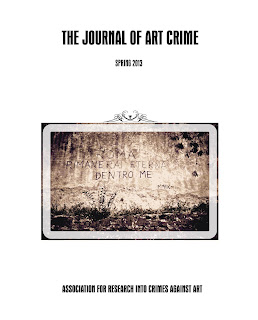Tuesday, August 06, 2013 -  Context Matters,Freeport,Orpheus mosaic,Polaroids,Spring 2013,The Journal of Art Crime,the medici conspiracy
Context Matters,Freeport,Orpheus mosaic,Polaroids,Spring 2013,The Journal of Art Crime,the medici conspiracy
 No comments
No comments
 Context Matters,Freeport,Orpheus mosaic,Polaroids,Spring 2013,The Journal of Art Crime,the medici conspiracy
Context Matters,Freeport,Orpheus mosaic,Polaroids,Spring 2013,The Journal of Art Crime,the medici conspiracy
 No comments
No comments
David Gill on "Dallas Museum of Art Takes the Initiative" in "Context Matters" (The Journal of Art Crime, Spring 2013)
 |
| David Gill |
The reporting and commentary on the so-called "Medici Conspiracy" has exposed the way that major North American museums acquired recently-surfaced antiquities (Watson and Todeschini 2006; Silver 2009; Felch and Frammolino 2011). This was in spite of the 1970 UNESCO on the Means of Prohibiting and Preventing the Illicit Import, Export and Transfer of Ownership of Cultural Property, the 1973 Declaration by the Archaeological Institute of America, the 1983 acceptance of the UNESCO convention by the US, and the varied acquisition policies of individual museums. Museums overlooked and ignored the ethical issues related to the damage of archaeological sites and, instead, emphasized the fact that they acquired objects in good faith and by legal means. Objects purchased through Switzerland, Paris, London, or New York were not considered to be problematic. The items had passed from their countries of origin to the international antiquities market. The release of the Medici Dossier photographs, seized in the Geneva Freeport, brought a sequence of major museums agreeing to hand over significant numbers of items: Boston's Museum of Fine Art, the Cleveland Museum of Arts, the J. Paul Getty Museum, the Minneapolis Institute of Art, New York's Metropolitan Museum of Art, the Princeton University Art Museum, and the Toledo Museum of Art (Gill and Chippindale 2006; 2007a; Gill 2009a; 2010). And it is clear that material in other major North American museums has been identified and that this shameful list will expand.
Professor David Gill is Head of the Division of Humanities and Professor of Archaeological Heritage at University Campus Suffolk, Ipswich, England. He is a former Rome Scholar at the British School at Rome, and was a Sir James Knott Fellow at the University of Newcastle upon Tyne. He was previously a member of the Department of Antiquities at the Fitzwilliam Museum, University of Cambridge, and Reader in Mediterranean Archaeology at Swansea University (where he also chaired the university's e-learning sub-committee). He is a Fellow of the Society of Antiquaries. he is the holder of the 2012 Archeological Institute of America (AIA) Outstanding Public Service Award, and the 2012 SAFE Beacon Award. He has published widely on archaeological ethics with Christopher Chippindale. He wrote a history of British archaeological work in Greece prior to the First World War in Sifting the Soil of Greece: The Early Years of the British School at Athens (1886 - 1919) (Bulletin of the Institute of Classics Studies, Supplement 111; London: Institute of Classical Studies, 2011), xiv + 474 pp.
Here's an excerpt from Professor Gill's column:
This column is included in the ninth issue of The Journal of Art Crime, edited by Noah Charney and published by ARCA, (available electronically and in print via subscription and Amazon.com.) The Associate Editor is Marc Balcells (ARCA '11), Graduate Teaching Fellow, Department of Political Science, John Jay College of Criminal Justice -- The City University of New York.Here's an excerpt from Professor Gill's column:
Are all the apples in the North American museum barrel rotten (Gill and Chippendale 2007b)? There is one clear exception that suggests that there is at lest one sensible voice of concern and reform. In January 2012, Maxwell Anderson, the newly appointed Director of the Dallas Museum of Art (DMA), became concerned about the museum's holding of material derived from Almagià. He clearly wanted to pre-empt any external investigation that could reveal embarrassing and potentially damaging information about the museum. Anderson decided to post details of the objects, along with their stated collecting histories, on the Association of Art Museum's Director's (AAMD) object register website. This website, hosted by Anderson's former institution, the Indianapolis Museum of Art, had been intended to be used for displaying information about new acquisitions, rather than reviewing the cases of older ones. Such a move indicated a major change in attitude toward the issue of toxic antiquities that were potentially lurking in the collections of North American museums.













